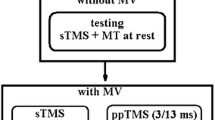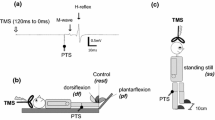Abstract
Long-latency electromyographic (EMG) responses can be evoked in the first dorsal interosseous muscle (FDI) by unexpected slips of an object (skin stretch) held between the index and thumb, or by forcible adduction of the metacarpophalangeal joint (muscle stretch). The former type of response is due to stimulation of tactile afferents in the skin of the digits, whereas the latter also activates muscle receptors. Previous studies have provided good evidence that long-latency reflex responses to stretch of distal muscles involve activity in a transcortical reflex pathway. The present experiments examined whether cutaneous reflexes also utilise a transcortical route. Transcranial magnetic or electrical stimuli were given over the motor cortex to evoke EMG activity during the period of the long-latency reflex response. When evoked by muscle stretch the responses to magnetic stimulation were facilitated more than those to electric stimulation. In contrast, facilitation was equal during the long-latency reflex elicited by cutaneous stimulation. Because of the different ways in which electrical and magnetic stimuli are believed to activate the motor cortex, we interpret these results to mean that the long-latency response to skin stretch is not mediated by a transcortical mechanism in the majority of subjects, whereas that following muscle stretch is. However, these are average data. In a few individual subjects, the opposite results were obtained. We suggest that there may be differences between subjects in the transcortical contribution to long-latency reflex responses. The implication is that, under normal circumstances, several pathways may contribute to these responses. If so, the relative roles of the pathways may change during different tasks, and in pathological states lesions in one system may well be accompanied by compensatory changes in other systems.
Similar content being viewed by others
References
Burke D, Hicks RG, Stephen JPH (1990) Corticospinal volleys evoked by anodal and cathodal stimulation of the human motor cortex. J Physiol (Lond) 425: 283–299
Burke D, Hicks RG, Gandevia SC, Stephen J, Woodforth I, Crawford M (1993) Direct comparison of Corticospinal volleys in human subjects to transcranial magnetic and electrical stimulation. J Physiol (Lond) 470: 383–393
Caccia MR, McComas AJ, Upton ARM, Blogg T (1973) Cutaneous reflexes in small muscles of the hand. J Neurol Neurosurg Psychiatry 36: 960–977
Cheney PD, Fetz EE (1984) Corticomotoneuronal cells contribute to long-latency stretch reflexes in the rhesus monkey. J Physiol (Lond) 349: 249–272
Cole KJ, Abbs JH (1987) Kinematic and electromyographic responses to perturbation of a rapid grasp. J Neurophysiol 57:1498–1510
Darton K, Lippold OC, Shahani M, Shahani U (1985) Long-latency spinal reflexes in humans. J Neurophysiol 53: 1604–1618
Datta AK, Harrison LM, Stephens JA (1989) Task-dependent changes in the size of response to magnetic brain stimulation in human first dorsal interroseous muscle. J Physiol (Lond) 418: 13–23
Day BL, Dressler D, Maertens de Noordhout A, Marsden CD, Nakashima K, Rothwell JC, Thompson PD (1989) Electric and magnetic stimulation of human motor cortex: surface EMG and single motor unit responses. J Physiol (Lond) 412: 449–473
Day BL, Riescher H, Struppler A, Rothwell JC, Marsden CD (1991) Changes in the response to magnetic and electrical stimulation of the motor cortex following muscle stretch in man. J Physiol (Lond) 433: 41–57
Deuschl G, Schenck E, Lucking CH (1985) Long-latency responses in human thenar muscles mediated by fast conducting muscle and cutaneous afferents. Neurosci Lett 55: 361–366
Deuschl G, Ludolph A, Schenck E, Lucking CH (1989) The relations between long-latency reflexes in hand muscles, somatosensory evoked potentials and transcranial stimulation of motor tracts. Electroencephalogr Clin Neurophysiol 74: 425–430
Deuschl G, Michels R, Berardelli A, Schenck E, Inghilleri M, Lucking CH (1991) Effects of electric and magnetic transcranial stimulation on long-latency reflexes. Exp Brain Res 83: 403–410
Doemges F, Rack PM (1992) Changes in the stretch reflex of the human first dorsal interosseous muscle during different tasks. J Physiol (Lond) 447: 563–573
Edgley SA, Eyre JA, Lemon RN, Miller S (1990) Excitation of the corticospinal tract by electromagnetic and electrical stimulation of the scalp in the macaque monkey. J Physiol (Lond) 425: 301–320
Evans AL, Harrison LM, Stephens JA (1989) Task-dependent changes in cutaneous reflexes recorded from various muscles controlling finger movement in man. J Physiol (Lond) 418: 1–12
Farmer SF, Ingram DA, Stephens JA (1990) Mirror movements studied in a patient with Klippel-Feil syndrome. J Physiol (Lond) 428: 467–484
Hore J, Preston JB, Durkovic RG, Cheney PD (1976) Responses of cortical neurones (areas 3a and 4) to ramp stretch of hindlimb muscles in the baboon. J Neurophysiol 39: 484–500
Jenner JR, Stephens JA (1982) Cutaneous reflex responses and their central nervous pathways studied in man. J Physiol (Lond) 333: 405–419
Johansson RS, Riso R, Häger C, Bäckström L (1992a) Somatosensory control of precision grip during unpredictable pulling loads. I. Changes in load force amplitude. Exp Brain Res 89: 181–191
Johansson RS, Häger C, Riso R (1992b) Somatosensory control of precision grip during unpredictable pulling loads. II. Changes in load force rate. Exp Brain Res 89: 192–203
Johansson RS, Häger C, Bäckström L (1992c) Somatosensory control of precision grip during unpredictable pulling loads. III. Impairments during digital anesthesia. Exp Brain Res 89: 204–213
Johansson RS, Lemon RN, Westling G (1994) Time varying enhancement of human cortical excitability mediated by cutaneous inputs during precision grip. J Physiol (Lond) 481: 761–775
Lemon RN (1979) Short-latency peripheral inputs to the motor cortex in conscious monkeys. Brain Res 161: 150–155
Macefield VG, Johansson RS (1994) Electrical signs of cortical involvement in the automatic control of grip force. Neuroreport 5: 2229–2232
Macefield VG, Johansson RS (1995) Control of grip force during restraint of an object held between finger and thumb: responses of muscle and joint afferents from the digits. Exp Brain Res 108: 172–184
Macefield VG, Häger-Ross C, Johansson RS (1995) Control of grip force during restraint of an object held between finger and thumb: responses of cutaneous afferents from the digits. Exp Brain Res 108: 155–171
Maertens de Noordhout A, Rothwell JC, Day BL, Dressler D, Nakashima K, Thompson PD, Marsden CD (1992) Effect of digital nerve stimuli on the responses to electrical or magnetic stimulation of the human brain. J Physiol (Lond) 447: 535–548
Marsden CD, Merton PA, Morton HB, Adam JER (1977a) The effect of lesions of the sensorimotor cortex and capsular pathways on servo responses from the human long thumb flexor. Brain 100: 503–526
Marsden CD, Merton PA, Morton HB, Adam JER (1977b) The effect of posterior column lesions on servo responses from the human long thumb flexor. Brain 100: 185–200
Marsden CD, Rothwell JC, Day BL (1983) Long-latency automatic responses to muscle stretch in man: origin and function. Adv Neurol 39: 509–539
Matthews PB (1991) The human stretch reflex and the motor cortex. Trends Neurosci 14: 87–91
Matthews PB, Farmer SF, Ingram DA (1990) On the localization of the stretch reflex of intrinsic hand muscles in a patient with mirror movements. J Physiol (Lond) 428: 561–577
Noth J, Friedemann HH, Podoll K, Lange HW (1983) Absence of long-latency reflexes to imposed finger displacements in patients with Huntington's disease. Neurosci Lett 35: 97–100
Ohki Y, Suzuki T, Ugawa Y, Uesaka Y, Sakai K, Kanazawa I (1994) Excitation of the motor cortex associated with the E2 phase of cutaneous reflexes in man. Brain Res 663: 343–347
Palmer E, Ashby P (1992a) Evidence that a long-latency stretch reflex in humans is transcortical. J Physiol (Lond) 449: 429–440
Palmer E, Ashby P (1992b) The transcortical nature of the late reflex responses in human small hand muscle to digital nerve stimulation. Exp Brain Res 91: 320–326
Phillips CG (1969) Motor apparatus of the baboon's hand. Proc R Soc Lond B Biol Sci 173: 141–174
Rothwell J, Burke D, Hicks R, Stephen J, Woodforth I, Crawford M (1994) Transcranial electrical stimulation of the motor cortex in man: further evidence for the site of activation. J Physiol (Lond) 481: 243–250
Thilmann AF, Schwarz M, Töpper R, Fellows SJ, Noth J (1991) Different mechanisms underlie the long-latency stretch reflex response of active human muscle at different joints. J Physiol (Lond) 444: 631–643
Thompson PD, Day BL, Rothwell JC, Dressler D, Maertens de Noordhout A, Marsden CD (1991) Further observations on the facilitation of muscle responses to cortical stimulation by voluntary contraction. Electroencephalogr Clin Neurophysiol 81: 397–402
Author information
Authors and Affiliations
Rights and permissions
About this article
Cite this article
Macefield, V.G., Rothwell, J.C. & Day, B.L. The contribution of transcortical pathways to long-latency stretch and tactile reflexes in human hand muscles. Exp Brain Res 108, 147–154 (1996). https://doi.org/10.1007/BF00242912
Received:
Accepted:
Issue Date:
DOI: https://doi.org/10.1007/BF00242912




